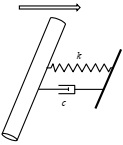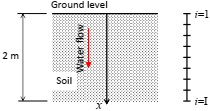Reference no: EM132298413 , Length: word count:3000
Instruction
- Students will develop CFD programs to solve simple problems in this project.
- There are two parts in this project, each student needs to complete the work assigned in each part and submit a written report.
- The report must be in the format of Miscrosft Word file and submitted through vUWS. Reports in hard copy will not be accepted.
Part one: Simple initial value problem
Assignment (please read the problem description before doing the assignment)
(1) Find out the equation of motion of the cylinder. The derivation procedure of the equation must be included in the report.
(2) Develop a numerical method for predicting the vibration of the cylinder. The procedure of deriving the FDM formula must be included in the report.
(3) Develop a MATLAB program for solving the problem. The MATLAB program code must be included in the report.
(4) Keeping the damping coefficient of c = 100 N-m/s, conduct numerical simulations for KC=2 to 20 with an interval of 2 and find out the variation of the power with the KC number.
(5) Keeping the KC number to be constant of KC=10, conduct numerical simulations for c=0 to 2000 N-m/s with an interval of 50 and find the variation of the power with c.
(6) In the report, show the time histories of the vibration for all the calculated cases.
(7) Discuss how KC and c affects the power generation.
Problem description
An energy extraction device includes a cylinder elastically mounted on a spring and the electricity generator. The cylinder vibrates only in a direction parallel to the flow and drives an electricity generator. The electricity generator extracts the energy from the cylinder in the same way as a damper. It is modelled as a damper with a damping constant c when the vibration is studied. The flow velocity is a combined steady and oscillatory flow
u(t) = U0 + Umsin(2Πt/T)
where U0 is the steady flow velocity, Um is the amplitude of the oscillatory flow velocity, T is the period of the oscillatory flow and t is the time.
The KC number is defined as
KC = UmT/D
Flow velocity u = U0 + Umsin(ωt)

The electricity generator can modelled by a damper that extract energy from the motion of the cylinder with a constant damping constant of c. The structural damping is considered to be negligibly small. The energy extracted from the motion by the electricity generator (damper) can be calculated by
P = 1/T 0∫T cV2dt
where P is the power of the system, F is the hydrodynamic force on the cylinder, V is the vibration speed of the cylinder. In the numerical simulation, the power can be calculated by
P = 1/N ∑Nn=1 c(Vn)2
where N is the total time step in one stable oscillatory flow period, Fn and Vn represent n-th step within one oscillatory flow period. The power must be calculated by stable numerical solution. The hydrodynamic force on the cylinder can be predicted by the Morison equation
Fwater = CAmd (dVr/dt) + 1/2ρCDAP|Vr|Vr
↑ ↑
Finertia Fdrag
where Vr = u-V is the velocity of the flow relative to the cylinder, CA and CD and inertia and drag coefficients, respectively, md is the displaced fluid mass and Ap is the projected area. The calculating parameters are listed in the table below.
Table 1 Parameter table
Note: In the table, the number j stands for the last digit of your student ID. For example, if your student ID is 2345673, 10+j = 13.
| Amplitude of the oscillatory flow velocity, Um |
1 + j/10 m/s
|
|
Steady flow velocity U0
|
0.1×Um m/s
|
|
Diameter of the cylinder, D
|
10+j cm
|
|
Length of the cylinder, L
|
1 m
|
|
Mass of the cylinder, m
|
50 kg
|
|
Density of the water, ρ
|
1024 kg/m3
|
|
Stiffness of the spring (total), K
|
200 N/m
|
|
Damping coefficient (total), c
|
10 N?m/s
|
|
Added mass coefficient (assume to be constant)
|
1
|
|
Drag coefficient (assume to be constant)
|
1.8
|
Part two: One-dimensional convection diffusion problem
Assignment (please read the problem description before doing the assignment)
- Develop a finite difference method (FDM) formula for solving the equation. The procedure of deriving the FDM formula must be included in the report.
- Develop a MATLAB program and use this program to do the simulation and answer the following questions. Divide the soil depth into 200 cells when solving the problem numerically. You must attach the MATLAB program in your report.
- If α=0.0002 m2/s, find out when the temperature at the depth of 1.5 m reaches 25°C.
- If the temperature at the depth of 1.5 m reaches 25°C is defined as T1.5, do the simulations for α in the range of 0.0002 m2/s to 0.001 m2/s with an interval of 0.0001 m2/s and discuss how α on T1.5 and why.
Problem description
Note: In the paragraph below, the number j stands for the last digit of your student ID. For example, if your student ID is 2345673, 10+j = 13.
The water on the ground flows into the soil through the pore space of the soil (the space between soil particles). The flow velocity is very small of 0.002×(1+j) m/s and it does not change along the vertical direction. Initially, the temperature is (10+j) °C in the whole soil volume (including soil and the water in the soil). The temperature of the water on top of the ground level is 30°C and remains constant. The warm water moves into the soil and increases the temperature in the soil.

A coordinate x is defined and its origin is on the ground level and pointing downwards. The governing equation is the convection diffusion equation
∂T/∂t = -u∂T/∂x + α∂2T/∂x2
where
T is the temperature in the soil
t is the time
u is the water flow velocity
α is the heat diffusion coefficient (the influence of the soil has been considered).
Boundary condition is T = 30°C at the top boundary and ∂T/∂x = 0 at the bottom boundary (at x= 2 m).